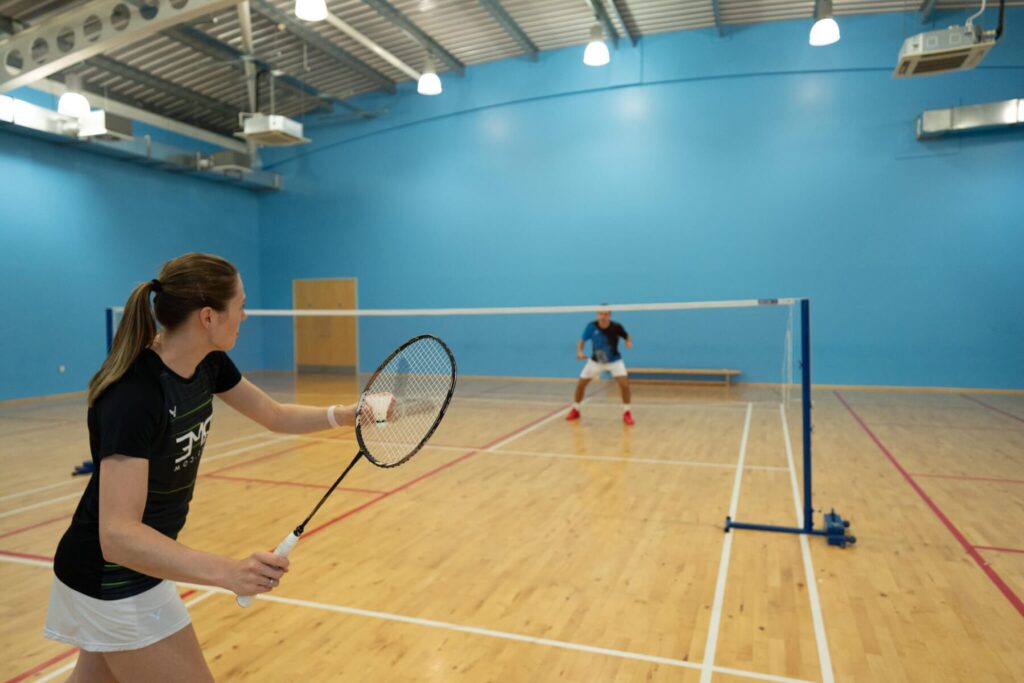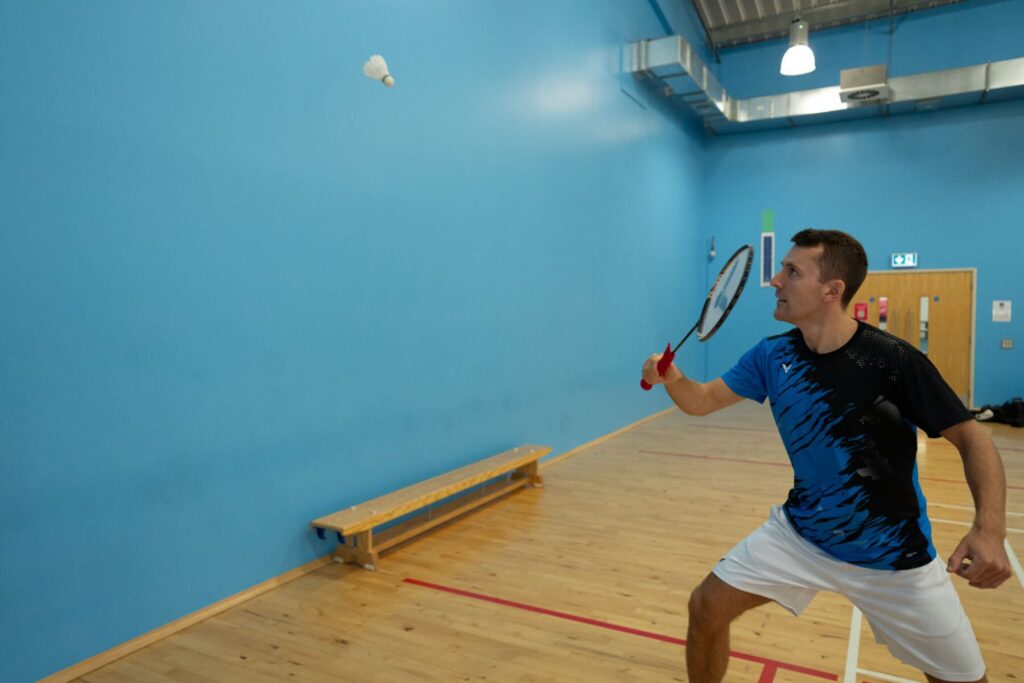How To Hit A Backhand Drive In Badminton: Step-By-Step Tutorial
A backhand drive in badminton is a shot most commonly played from the mid-court. It is an attacking shot that should pass close to the net with a flat trajectory. A good backhand drive should be consistent, accurate and powerful.
You can improve your backhand drive by learning the correct technique. First you need to learn the footwork. You should step forward with your racket leg and land just after hitting the shot. You then need to learn the hitting technique, where you should use a backhand grip and short swing.
We’ll now teach you the footwork and hitting technique in detail before discussing where you should hit your backhand drive to, as well as giving you helpful drills to practice and improve your backhand drive in badminton.
Footwork: How should you move To the backhand drive?
After performing a split step, you should pivot on your non-racket leg before moving into the final step. This is the most important part of the footwork.
You want to step forward with your racket leg as this increases the force going into the shot. This can help you generate extra power and also make you look more intimidating.
Of course, there will be some situations where you’re not able to use this footwork – for example when the shuttle is coming at you too quickly. But for the perfect drive, stepping forward is ideal because if you step sidewards or even slightly backwards into the drive, you are not able to use your body weight or momentum as much.
The timing of your racket foot is also really important. Ideally, you want to land just before you strike the shuttle (milliseconds!). This improves your control, and you can also use this extra force from the step to add even more power to your drive.

Hitting Technique: How should you hit the backhand drive?
Step 1: Use a loose backhand grip, with your thumb on the wider part of the grip, as shown below. This enables you to use your thumb to generate sufficient power in the shot.

If you are interested, you can learn more about the different badminton grips here.
Step 2: Have your racket around hip height as your opponent is about to play their shot so you waste no time bringing it up to play the backhand drive! A lower racket carriage means you will be later onto the shot since your first movement will be bringing your racket up.


Step 3: As the shuttle approaches you, bring your arm back a little, as shown below.
But we don’t recommend too big of a backswing because you’re:
- More likely to mistime the shot,
- Have a slower recovery,
- And it isn’t always about hitting as hard as you can (which we’ll touch more on later).


If you do opt for a bigger swing, an easy way to learn the technique is to pretend to look at a watch on your wrist, whilst ensuring the strings of your racket are facing the ceiling, and then squeeze your grip pushing with your thumb to rotate so that your strings are now facing the floor.
Step 4: As the shuttle is approaching you, you want to bring your arm back and then use the muscles in the back of your shoulder, then forearm, and wrist to come through and strike the shuttle!
At the point of contact, squeeze your fingers and thumb as you exert power as if you’re punching the shuttle with your racket. Don’t forget to step forward into the shot with your racket leg too!
💡Top Tip: A slight bend in the arm as you hit the drive is optimal - not completely straight and not too bent either.
The more you practice the backhand drive, the easier and more ‘natural’ it will become! A weak backhand drive may be down to poor footwork (such as the timing of your step) or poor hitting technique (such as not being in a backhand grip).
We would recommend focusing on using a shorter swing first and then once you improve the ability to generate a fast racket speed in this shot, you can then experiment with having a slightly bigger swing. As we always say, there is no right or wrong and even many professionals will have contrasting techniques, however they all develop these basic fundamentals first.
If you find it difficult to improve the power of your backhand drive you should consider placing a large importance on the placement of your shots, which is what we will discuss now!
Placement: Where should you play the backhand drive to?
Similar to smashes (which you can learn more about here), good places to play the backhand drive are:
- Straight down the tramline
- Down the middle to create indecision, or set your partner up for the rotation
- Cross-court – although this can be risky if you don’t time it correctly!
REMEMBER: It isn’t all about power as the placement of the shot is also very important! Sacrificing some power but placing the shuttle exactly where you want to is MUCH better than using 100% power but having no control of where the shuttle is going.
Placing the shuttle effectively enables you to set yourself or your partner up for the next shot, rather than playing straight to your opponent’s racket and putting yourself under more pressure!
Similarly, when you’re taking the shuttle below the height of the net, you want to avoid hitting with 100% power. This is because the shuttle will inevitably travel upwards. This combined with worse placement makes it easier for your opponents to play an attacking return and therefore putting yourself under pressure.
Drills: 5 ways to practice your backhand drive
1. Multi-Shuttle Drill
- Get your training partner to feed the shuttle, one at a time, to the mid-court so you can hit the backhand drive shot
- You can alternate sets with a heavy training racket (if you have one) and normal racket
- We recommend doing 1X 16 shuttles with a heavy racket, then 1X 16 shuttles with a normal racket straight after that, before switching over with your partner
💡Top Tip: Playing with a heavy racket can help increase forearm, wrist and finger power which is very important for the backhand drive!

2. Single Shuttle Drill
- Play drives back and forth with your partner using a single shuttle
- Again, you can alternate between using a heavy and normal racket
- We recommend doing 90 seconds per set
3. Practicing Alone
If you don’t have a training partner but still want to practice your drives, try hitting against a wall!
- Aim slightly higher to make sure you’re in the drive position
- Focus on your power and consistency first
- Then as you get better, you can introduce a bit of movement e.g. stepping into the drive

4. 2-Shot Combination Drill
To introduce more movement into your practice, you can try doing a 2-shot combination drill. For example:
- Playing a smash followed by a backhand drive
- Playing a forehand drive followed by a backhand drive
5. Open Routines
To replicate more of a match situation, you can practice doing the backhand drive in more open routines such as the rear-mid exercise. To learn more about this exercise check out this article here.
Learn More
Now that we’ve gone through the correct footwork, technique, placement and practices for perfecting the backhand drive in badminton, we hope you’ve learned some good tips that you can implement into your own training and games!
If you want to see visual examples of what we have discussed, you can watch our YouTube video on how to play a perfect backhand drive below.

